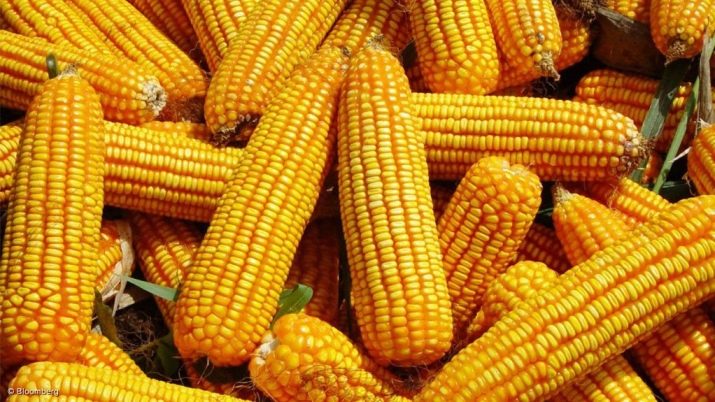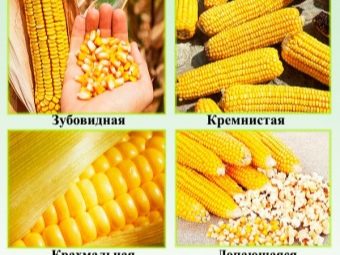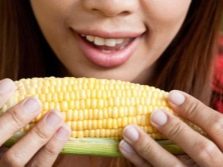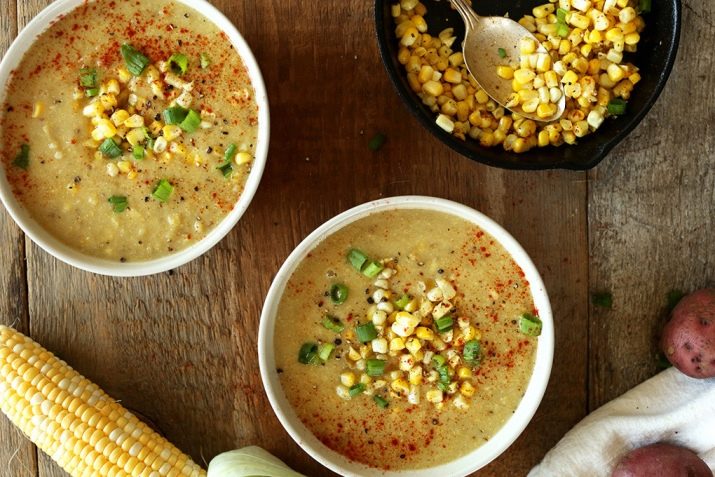Corn: is it a fruit, vegetable, or cereal, and to which family does it belong?

Some people are still arguing about what kind of plants the corn belongs to, despite the fact that botanists today have been able to quite accurately describe it.What is this plant: corn, or maize, is a cereal, a vegetable, a bean or a fruit, and from where disputes about its classification originate, will be discussed in this article.
Description
According to its characteristics, corn is mostly cereal. The flowering process, the structure of the leaves, the ripening of the fruit and their appearance indicate a similar affiliation. However, in contrast to the typical cereal in corn, the inner space of the stem does not consist of emptiness, but of a loose substance called parenchyma. It is understandable, to reach two or more meters in height with a hollow stem would be impossible.
With the root system, too, everything is ambiguous, because it is more like the roots of a banana bush. And this similarity is not surprising, since corn, like a banana, has to bear the weight of hard fruits. Therefore, again, the external features of both the plant itself and its fruits lead the yellow spike away from the family of cereals.
In any case, despite the difference in sizes and types of root systems, the stalk and leaves of corn are excellently suitable as feed for livestock, as well as other cereals.
Next, consider what is the basis of attempts to attribute corn to vegetables, fruits or beans. In fact, if we discard the botanical characteristics, then only conditionally yellow cob can be attributed to one of the cultures. And this is explained by the fact that in the botanical definition there is no such thing as a “fruit”. From the Latin fructus translated as "fruit". And this word botanists gave a precise definition, but if we summarize, it turns out that the fruit is a product obtained as a result of the ovary of a flower with its subsequent fertilization. That is, if you start from what is written, corn stands on one side with a banana, tomato and beans.
And even the cereals themselves, albeit remotely, can be attributed to fruit.
Origin of culture
If everything became clear with this question, then it is possible to talk in more detail about the corn itself, because this is quite a controversial and interesting fruit, not only from the side of botanical determination.
For the first time a plant with a yellow cob began to be mastered by people around 9 thousand years BC. e. It is assumed that the birthplace of maize is located in the area of modern Mexico. And if it is more or less clear where corn originated, then the question of its origin can still be a controversial topic in certain circles.
There are a number of supporters of extraterrestrial or divine origin of maize. The essence of both sides is about the same: aliens from space (gods) landed on the earth, who presented people with such valuable fruit.
The impetus for the development of these theories was the following circumstance: corn, as everyone knows it today, is unable to grow without human help. If you do not harvest in time, the fallen cob is likely to simply rot, and with less, the seeds will still germinate, but will not be able to survive due to the high competition among themselves for nutrients.
In this case, the skeptic would suggest that there should have been wild ancestors, from which they could get modern maize through multiple crosses. But even today, indeed, such a culture has not been found, which would definitely be the direct progenitor. From this several hypotheses of already more mundane sense follow. If all of them lead to a common denominator, then the following will turn out: despite the fact that wild corn still exists in nature, it is apparently not a real ancestor of the present. If kinship is possible, then only under the condition that the wild culture served as only one of the parents. The yellow cob, familiar to everyone, most likely appeared from interaction with teosinte.
Teosinte is a cereal similar to corn, but no longer externally but internally. According to genetic parameters, this is the same species, and possible combinations of their properties could contribute to the production of modern maize.
In addition, by adding to this theory the selective influence of a person and the effect of positive mutations on maize, there is no doubt about the viability of such an opinion.
Kinds
Modern methods of breeding made it possible to observe today many different varieties of corn.
Themselves species are only 8, only 5 of which are of value to humans.
- Toothed. One of the most cultivated species of maize. He is able to bring a very good harvest from a relatively small area of land. The name received for the peculiarity of the appearance of the grains, similar to human teeth. Dental corn is grown mainly in America and, as a rule, is used as animal feed.
- Sugar. This is perhaps the most familiar and favorite kind of corn for residents of the post-Soviet space. Such fame is due to the ability to get a bountiful harvest in combination with high nutritional values (the amount of protein can reach 20 g per 100 g of product). And of course, the pleasant sweet taste played a significant role in popularizing the species.
- Silicic. This type of corn has an unusual appearance. In a ripe fruit, grains differ in color from white to black. The silicon species has its strong and weak points. One of the advantages is a good resistance to low temperatures, a strong immune system that prevents fungal diseases, and a good harvest in a short time. As a negative point, some farmers note relatively low yields.
- Starchy. As you might guess from the name, there is a lot of starch in this variety (up to 80%). And the purpose of its cultivation is primarily to obtain the starch itself, as well as flour, molasses and alcohol.
- Bursting. Another familiar kind of corn. When heated, small grains have the peculiarity of bursting and increasing significantly in size. Popcorn is made from this kind. Even there is evidence that the ancient Maya were also familiar with similar properties of maize and often used it in this form.
Cultivation
Corn is a rather unpretentious plant, though not as much as Khrushchev would have liked it to be. Therefore, it should be borne in mind that the ideal growing area is subtropics. There maize can be sown in mid-May directly into the ground.
But even in warm conditions, the light-loving nature of the plant does not allow a thick landing. Therefore, a large amount of growing in one place of corn will not give a gain in yield. On the contrary, from such a number of neighbors there will be strong competition for the main resource - sunlight. Based on this, the optimum area for plant development is 70x70 cm. The grain itself is planted in warm, moist soil to a depth of 5-7 cm.
Subtropics are ideal conditions, but the southern territory is not the only place where maize is able to feel comfortable. The growing area can expand significantly, if you pay attention to some features. For example, in regions with a short summer, planting seeds directly into the ground would not be the best idea. If there is a harvest, it will be rather meager. The solution in this situation is quite simple - pre-cultivation of seedlings in protected ground. Thus, the plant has much more time for the formation of ripe fruits.
And in whatever climate the grower wants to grow corn, all efforts will be in vain without proper soil preparation. Lucky only those who already have at their disposal fertile black soil. The rest will have to spend some time to the land on the site is enriched with minerals. In the fall, you need to fertilize the soil with rotted manure or harvested humus. And during flowering to make ash as a fertilizer, diluting it with water.
Thus, the maize will have enough nutrients to form large cobs.
Benefit
Those people who ranked corn as a gift from an extraterrestrial mind or gods did not just give her so much attention. The list of benefits brought by the plant is already delighting, and modern technologies still continue to reveal new advantages.
Food
More than once in the article mentioned the great nutritional value of corn for humans. In more detail, there are many vitamins in it: A, C, PP, E and Group B. And also it is rich in 27 minerals from the periodic table. And to all other, it has a high-quality protein composition, including such important essential amino acids as leucine, isoleucine and valine.
Medical
Almost all parts of the maize are suitable for medical use. There are many diseases that can be treated or at least do not start their course thanks to this plant. Corn preparations are well established in urology as a diuretic. And the ability to normalize blood glucose levels allowed the use of maize in diabetic medications. And, of course, the fruits of the plant have a beneficial effect on the stomach.
Therefore, the inclusion of corn soup in the diet for gastritis would be the right decision.
Ecological
This is exactly the area thanks to which new advantages of maize are revealed.
- Textile. Now, instead of synthetic fabric, they have learned to make organic corn, which has all the advantages of the first, but no longer a threat to the environment.
- Plastic. World production of plastic, accompanied by large emissions of carbon dioxide, still remains at a high level. The problem is aggravated by the fact that only a small part of it is sent for recycling. The first manufactured plastic products are likely to lie in the ground for another 300 years before they can decompose. But things are not so bad, because as an alternative, more and more biodegradable materials appear. And today, a transparent bottle or a bag of corn will not differ from its plastic counterparts except for one thing: these things do not destroy the planet.
In conclusion, we can say that from whatever side you approach the classification of corn, considering it to be cereal or fruit, this will not reduce the contribution that it already makes and will make further in people's lives.
You will learn more about corn from the following video.
































